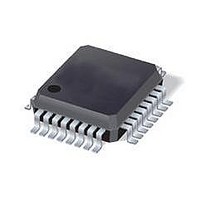ST7FLITE49K2T6TR STMicroelectronics, ST7FLITE49K2T6TR Datasheet - Page 39

ST7FLITE49K2T6TR
Manufacturer Part Number
ST7FLITE49K2T6TR
Description
IC MCU 8BIT 8K FLASH 32LQFP
Manufacturer
STMicroelectronics
Series
ST7r
Datasheet
1.ST7FLITE49K2T6TR.pdf
(245 pages)
Specifications of ST7FLITE49K2T6TR
Core Processor
ST7
Core Size
8-Bit
Speed
8MHz
Connectivity
I²C, SPI
Peripherals
LVD, POR, PWM, WDT
Number Of I /o
24
Program Memory Size
8KB (8K x 8)
Program Memory Type
FLASH
Eeprom Size
256 x 8
Ram Size
384 x 8
Voltage - Supply (vcc/vdd)
2.4 V ~ 5.5 V
Data Converters
A/D 10x10b
Oscillator Type
Internal
Operating Temperature
-40°C ~ 85°C
Package / Case
32-LQFP
Processor Series
ST7FLITE4x
Core
ST7
Data Bus Width
8 bit
Data Ram Size
384 B
Interface Type
I2C, SPI
Maximum Clock Frequency
8 MHz
Number Of Programmable I/os
24
Number Of Timers
4
Maximum Operating Temperature
+ 85 C
Mounting Style
SMD/SMT
Development Tools By Supplier
ST7FLITE-SK/RAIS, ST7FLI49M-D/RAIS, STX-RLINK
Minimum Operating Temperature
- 40 C
On-chip Adc
10 bit, 10 Channel
For Use With
497-8399 - BOARD EVAL ST7LITE49M/STLED316S497-5858 - EVAL BOARD PLAYBACK ST7FLITE
Lead Free Status / RoHS Status
Lead free / RoHS Compliant
Available stocks
Company
Part Number
Manufacturer
Quantity
Price
Company:
Part Number:
ST7FLITE49K2T6TR
Manufacturer:
STMicroelectronics
Quantity:
10 000
- Current page: 39 of 245
- Download datasheet (4Mb)
ST7LITE49K2
Caution:
7.1.2
1. The DEE0h, DEE1h, DEE2h and DEE3h addresses are located in a reserved area in non-volatile memory.
In 38-pulse ICC mode, the internal RC oscillator is forced as a clock source, regardless of
the selection in the option byte.
Section 13: Electrical characteristics on page 192
and accuracy of the RC oscillator.
To improve clock stability and frequency accuracy, it is recommended to place a decoupling
capacitor, typically 100 nF, between the V
V
These bytes are systematically programmed by ST, including on FASTROM devices.
If the voltage or temperature conditions change in the application, the frequency may need
to be recalibrated. Refer to application note AN1324 for information on how to calibrate the
RC frequency using an external reference signal.
Auto-wakeup RC oscillator
The ST7LITE49K2 also contains an Auto-wakeup RC oscillator. This RC oscillator should be
enabled to enter Auto-wakeup from halt mode.
The Auto-wakeup (AWU) RC oscillator can also be configured as the startup clock through
the CKSEL[1:0] option bits (see
This is recommended for applications where very low power consumption is required.
Switching from one startup clock to another can be done in run mode as follows (see
Figure
Case 1 Switching from internal RC to AWU
1.
2.
3.
4.
5.
Case 2 Switching from AWU RC to internal RC
1.
2.
3.
4.
5.
SSA
They are read-only bytes for the application code. This area cannot be erased or programmed by any ICC
operations.
For compatibility reasons with the SICSR register, CR[1:0] bits are stored in the 5th and 6th position of
DEE1 and DEE3 addresses.
Set the RC/AWU bit in the CKCNTCSR register to enable the AWU RC oscillator
The RC_FLAG is cleared and the clock output is at 1.
Wait 3 AWU RC cycles till the AWU_FLAG is set
The switch to the AWU clock is made at the positive edge of the AWU clock signal
Once the switch is made, the internal RC is stopped
Reset the RC/AWU bit to enable the internal RC oscillator
Using a 4-bit counter, wait until 8 internal RC cycles have elapsed. The counter is
running on internal RC clock.
Wait till the AWU_FLAG is cleared (1AWU RC cycle) and the RC_FLAG is set (2 RC
cycles)
The switch to the internal RC clock is made at the positive edge of the internal RC clock
signal
Once the switch is made, the AWU RC is stopped
pins as close as possible to the ST7 device.
12):
Section 14.1: Option bytes on page
DD
and V
for more information on the frequency
SS
Supply, reset and clock management
pins and also between the V
230).
DDA
39/245
and
Related parts for ST7FLITE49K2T6TR
Image
Part Number
Description
Manufacturer
Datasheet
Request
R

Part Number:
Description:
STMicroelectronics [RIPPLE-CARRY BINARY COUNTER/DIVIDERS]
Manufacturer:
STMicroelectronics
Datasheet:

Part Number:
Description:
STMicroelectronics [LIQUID-CRYSTAL DISPLAY DRIVERS]
Manufacturer:
STMicroelectronics
Datasheet:

Part Number:
Description:
BOARD EVAL FOR MEMS SENSORS
Manufacturer:
STMicroelectronics
Datasheet:

Part Number:
Description:
NPN TRANSISTOR POWER MODULE
Manufacturer:
STMicroelectronics
Datasheet:

Part Number:
Description:
TURBOSWITCH ULTRA-FAST HIGH VOLTAGE DIODE
Manufacturer:
STMicroelectronics
Datasheet:

Part Number:
Description:
Manufacturer:
STMicroelectronics
Datasheet:

Part Number:
Description:
DIODE / SCR MODULE
Manufacturer:
STMicroelectronics
Datasheet:

Part Number:
Description:
DIODE / SCR MODULE
Manufacturer:
STMicroelectronics
Datasheet:

Part Number:
Description:
Search -----> STE16N100
Manufacturer:
STMicroelectronics
Datasheet:

Part Number:
Description:
Search ---> STE53NA50
Manufacturer:
STMicroelectronics
Datasheet:

Part Number:
Description:
NPN Transistor Power Module
Manufacturer:
STMicroelectronics
Datasheet:

Part Number:
Description:
DIODE / SCR MODULE
Manufacturer:
STMicroelectronics
Datasheet:











